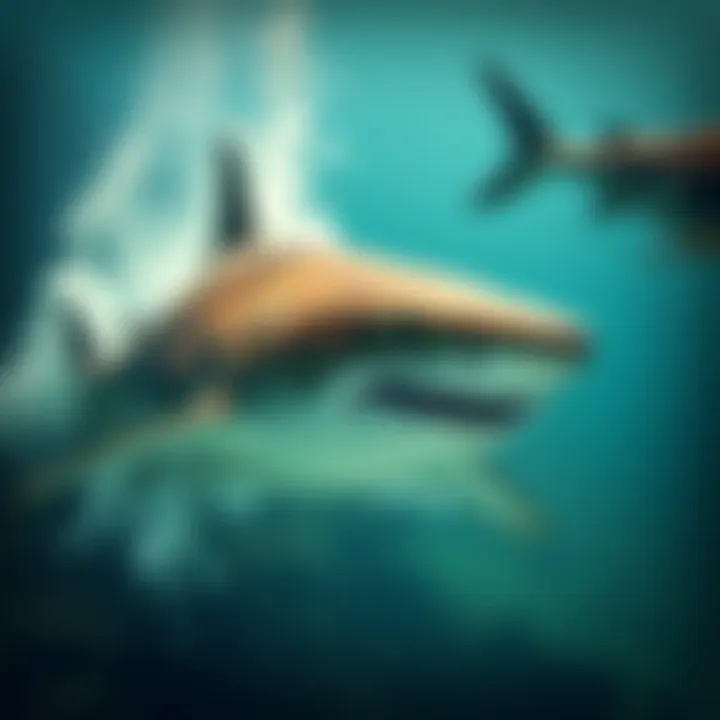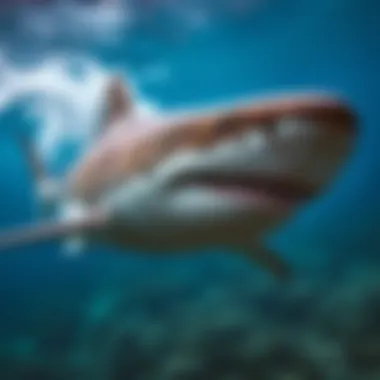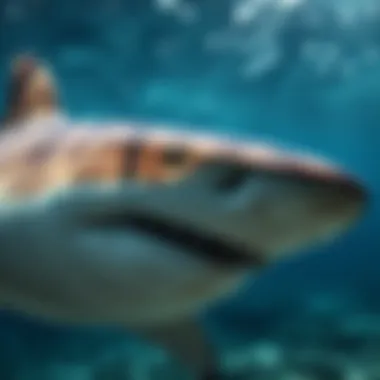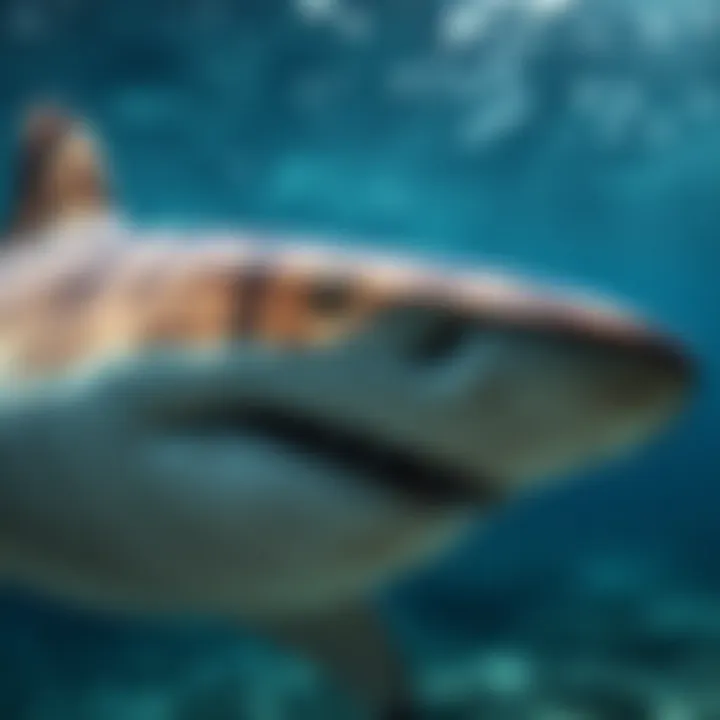Exploring Shark Diversity: Species, Ecology, and Habitat


Intro
Sharks have intrigued humankind for centuries, thanks to their powerful presence in the ocean's depths and their essential role in marine ecosystems. These creatures come in all shapes and sizes, presenting a vibrant tapestry of diversity that is hardly matched in the animal kingdom. Every species has its own story, adaptations, and behaviors that contribute to the health of the oceans.
Understanding the range of shark species goes beyond simple curiosity; it is crucial for fostering conservation efforts and appreciating the delicate balance of marine life. By exploring the unique traits and ecological roles of these predators, we not only become better surfboard riders but also advocates for their survival.
Next up, we’ll take a deep dive into various shark types, categorizing them by their physical characteristics, behaviors, and habitats. From the notorious great white to the lesser-known cookiecutter shark, each possesses distinct features that make them intriguingly complex. With a focus on marine life enthusiasts, beginner surfers, and seasoned ocean explorers, this article aims to enrich your understanding of sharks while emphasizing their critical environmental roles.
The Facets of Shark Diversity
Sharks are some of the most remarkable and varied creatures in our oceans, showcasing an extensive range of diversity that goes beyond merely their shapes and sizes. This section aims to explore the integral aspects of shark diversity, dissecting its significance in marine ecosystems and human understanding of these remarkable beings.
Prologue to Sharks
Sharks, belonging to the subclass Elasmobranchii, have roamed the Earth for over 400 million years. They come in numerous forms, sizes, and behavioral patterns. Whether it's the sleek form of a Great White or the gentle giant of the Whale Shark, each species plays a valuable role in their environment. The adaption of their bodies to diverse habitats—from coastal shores to open ocean waters—illustrates their evolutionary success.
It's not just their appearance that varies; their ecological niches are different too. Some sharks are predators at the top of the food chain, while others fulfill different roles. Many people are surprised to learn that not all sharks are fearsome predators; some are filter feeders, like the Whale Shark, eating small fish and plankton. The dynamic between these various species contributes to the balance of the marine ecosystem.
Evolutionary Background
The evolutionary journey of sharks illustrates an incredible narrative of adaptation and survival. Originally, sharks evolved from simpler forms of fish, with their ancestors appearing during the Devonian period. This time is often considered the "Age of Fish." Over millions of years, sharks developed unique features like cartilaginous skeletons, multiple rows of teeth, and highly advanced sensory systems.
Interestingly, sharks exhibit a significant degree of morphological and behavioral variations, stemming from their adaptive radiation. For instance, the basking shark has evolved to filter feed in the ocean’s upper layers, while the Bull Shark can tolerate freshwater, showcasing an adaptability that is rarely found in marine life.
"Sharks are living fossils, and studying their history offers insights into the health of our oceans, showcasing ancient lineages that have navigated the waters long before humans existed."
Ecological Significance
The ecological importance of sharks cannot be overstated. As apex predators, they help maintain the balance in ocean ecosystems. They regulate the populations of other species, which in turn supports the health of coral reefs and seagrass beds.
When these top predators decline in numbers, there are often disastrous effects on the entire marine environment. For example, the decline of sharks can lead to an overpopulation of smaller fish, which may overgraze on vital habitats. This cascading effect poses a threat not only to marine biodiversity but also to industries reliant on these ecosystems, such as fishing and tourism.
Categorizing Shark Species
The sheer variety of sharks roaming our oceans makes categorizing these species not just a scientific endeavor, but a crucial element in understanding their unique ecological roles. By classifying sharks, we create a framework through which we can appreciate their diversity, thereby shedding light on factors such as their behaviors, habitats, and the vital roles they hold in marine ecosystems. This categorization helps other enthusiasts, researchers, and conservationists focus on specific groups, understand threats to their survival, and implement effective conservation methods.
Classification Overview
Sharks belong to the class Chondrichthyes, which features a skeleton made of cartilage rather than bones, this differs them significantly from other fish. Within this class, sharks are categorized into several orders and families based on physical characteristics, genetics, and ecological niches. For example, the order Lamniformes includes powerful sharks such as the Great White and the Mako Shark, renowned for their speed and size.
Them differentiating between species is not merely an intellectual exercise; it helps us understand the feeding patterns, reproductive strategies, and social structures inherent to different shark types. Here are few major classifications:
- Lamniformes: These sharks are often fast and large, dominating the pelagic zones.
- Carcharhiniformes: Known for their diverse shapes and sizes, many of these species inhabit coastal waters.
- Orectolobiformes: Often referred to as carpet sharks, many of these species blend into their environments for camouflage.
Recognizing these classifications aids in fostering a respect for the diverse adaptations and behaviors sharks possess, showing how these creatures survive and thrive in various maritime habitats.
Common Family Traits
While each shark species exhibits distinct characteristics, certain traits can be found within specific families that unite them. Recognizing these commonalities can enhance our understanding of their ecological interactions and adaptive strategies.
Traits to Note:
- Physical Features: Many sharks, for instance, have streamlined bodies suited for speed and agility, while others, like the Whale Shark, have broad mouths for filter-feeding.
- Dietary Patterns: Predatory habits can vary; for example, Tiger Sharks are opportunistic feeders, consuming a range of prey including fish, seabirds, and even human refuse. In contrast, the Whale Shark primarily feeds on plankton.
- Reproductive Strategies: Different families exhibit varying reproductive methods. Hammerhead sharks, for instance, are known to give live birth, while Bull Sharks are often observed to be more aggressive in their mating confrontations.
Through this lens, we not only appreciate the diversity among sharks but also grasp the intricacies that make them vital to their ecosystems. For a clearer understanding of these traits, referencing detailed studies, such as those found on Britannica or exploring data on Wikipedia can be beneficial.
In summary, classifying sharks by their family traits not only assists in educational endeavors but also highlights the importance of each species within the broader marine environment.
Types of Sharks Found in Coastal Waters


Coastal waters play host to a remarkable variety of shark species, each adapted to thrive in this rich and dynamic environment. These waters, often bustling with life, are not only essential for the health of marine ecosystems but also critical for human recreation and tourism. Understanding the types of sharks found here can provide surfers, travelers, and outdoor enthusiasts with valuable insights. This knowledge can enhance their appreciation of the marine environment, potentially influencing responsible interactions with these magnificent creatures.
Coastal Species
Coastal sharks include a diverse range of species that occupy crucial ecological niches. Among them, the Great White Shark, known for its imposing presence, often prowls the depths near shores. These apex predators regulate other populations, helping maintain a balance within marine ecosystems. Another noteworthy coastal species is the Bull Shark, famous for its adaptability. This chameleon of the sea can thrive in freshwater and saltwater alike, often swimming far up rivers, which allows it to tap into new resources for prey.
Additionally, smaller coastal sharks like the Nurse Shark and the Blacktip Reef Shark frequent shallow waters, often found near coral reefs. With their unique adaptations, these sharks contribute to healthy reef systems.
- Great White Shark: Apex predator, vigilance keepers of the ecosystem.
- Bull Shark: Adaptable, known for entering freshwater environments.
- Nurse Shark: Bottom dwellers, often seen resting on the ocean floor.
- Blacktip Reef Shark: Commonly found near reefs, significant in maintaining coral health.
These species showcase not only the diversity but also the importance of sharks in coastal waters. Each species plays a role, whether it's regulating fish populations or maintaining the health of coral systems.
Recreational Importance
The presence of sharks in coastal areas holds significant recreational value. Surfers and divers, often drawn to coastal waters, can experience the thrill of interacting with these creatures. Encountering a shark while surfing may stir mixed feelings, but education reduces fear. Awareness of shark behavior empowers enthusiasts to make safer choices.
Sharks like the Hammerhead and Tiger Shark are not just fascinating to observe—they can also influence tourism positively. Eco-tourism, focused on responsible shark encounters, has become a lucrative venture in many coastal regions. Visitors travel from far and wide to witness these creatures in their natural habitats, boosting local economies while promoting conservation.
Engaging with sharks in their habitats fosters appreciation while supporting conservation efforts.
The mix of excitement and education that accompanies recreational activities in coastal shark habitats showcases their importance in preserving biodiversity and fostering a greater understanding of marine life.
Pelagic Sharks in the Open Ocean
Pelagic sharks, the nomadic giants of the high seas, carry with them a myriad of ecological responsibilities. These creatures are not just random inhabitants of the ocean; their presence plays a pivotal role in maintaining the balance of marine ecosystems. In exploring this section, one must pay heed to understanding their migratory behaviors and the vital function they serve globally.
Migratory Behaviors
Migration patterns among pelagic sharks are nothing short of extraordinary. Many species, such as the great white shark and the blue shark, embark on lengthy journeys across vast oceanic expanses in search of food, mates, and optimal water conditions. These migrations can cover thousands of miles and are often influenced by environmental factors like ocean currents, temperature variations, and the availability of prey.
What’s particularly fascinating is how these sharks utilize various migratory pathways, often returning to the same sites year after year. For surfers and marine enthusiasts, understanding these patterns can offer insights into the times and places where one might encounter these magnificent animals. It can also aid in predicting their behaviors and interactions with other marine species.
- Sharks migrate to:
- Locate food sources – often hunting for schools of fish or seals.
- Breed in specific areas that provide optimal conditions for raising young.
- Avoid changing ocean conditions that may affect their survival.
Did You Know? Some sharks have been tracked swimming over 2,000 miles in search of food and warmer waters.
Role in Global Ecosystems
Pelagic sharks serve as apex predators, effectively regulating the populations of various marine species and contributing to the health of oceanic ecosystems. Their presence ensures a balanced food web, helping to maintain the life cycle of numerous organisms within the marine environment. Population declines in shark species can trigger domino effects, leading to overpopulation of prey species and disturbing the delicate equilibrium.
Ecological Functions of Pelagic Sharks:
- Predation: They keep fish populations in check, which can prevent the overgrowth of certain species that might dominate an ecosystem and lead to biodiversity loss.
- Nutrient Cycling: By hunting and scavenging, they also play a role in recycling nutrients back into the ecosystem, which fosters the growth of various marine life forms.
- Indicator Species: Their health can indicate the status of ocean health, which speaks volumes about the impacts of climate change and human activities.
"The health of pelagic sharks signals the wellbeing of our oceans. When they thrive, the entire ecosystem flourishes."
In sum, pelagic sharks are not mere creatures of the ocean— they are essential players in our global ecosystems, highlighting the crucial need for their conservation. Their migratory tales tell us much about the oceans' health, and understanding their roles paves the way for more robust conservation efforts.
Deep-Sea Sharks: Adaptations and Characteristics
Deep-sea sharks represent a unique aspect of marine biology, continually captivating researchers and ocean enthusiasts alike. Found in some of the most inhospitable environments on Earth, these creatures have developed remarkable adaptations that allow them to thrive in the deep, dark, and often cold waters of the ocean. In this section, we will explore these adaptations and discuss their ecological significance, shedding light on this lesser-known group of sharks that play a vital role in maintaining the health of marine ecosystems.
Unique Features
Deep-sea sharks exhibit a range of specialized traits tailored for survival in extreme conditions. One standout characteristic is their slower metabolisms, enabling them to conserve energy in an environment where food is scarce. Sharks like the cookiecutter shark possess bioluminescent cells that can create mesmerizing light patterns, aiding in camouflage and attracting prey. Interestingly, some deep-sea species have developed large, sensitive eyes suited for minimal light, aiding in locating food in pitch darkness.
Another notable feature is their skin, which is often more flexible than that of their shallow-water cousins. This adaptation allows for better maneuverability in tight spaces found among underwater structures and prey. In addition, many deep-sea sharks, like the gulper shark, have unique jaw structures that can expand significantly, enabling them to consume prey much larger than themselves.


"Deep-sea sharks are among the planet's most intriguing creatures, each adaptation crafted over millions of years showcases the wonders of evolution and survival."
Feeding Habits
The feeding habits of deep-sea sharks are as varied as their adaptations. Some species, such as the lanternshark, are nocturnal hunters, using their keen sense of smell to locate prey in the inky depths. Their diet typically includes smaller fish, cephalopods, and crustaceans which suffer the consequences of their sudden ambush tactics. In contrast, the megamouth shark is known for its passive feeding strategy. This shark, with its enormous mouth, swims through the water, filtering plankton and small fish, truly a gentle giant of the deep.
To adapt to the scarcity of food, many deep-sea species maintain a diverse diet, consuming various organisms that descend into their territory. This ability helps counterbalance the unpredictability of food availability, ensuring their survival despite the challenges of their environment. Interestingly, some deep-sea sharks, like the frilled shark, are known to eat prey whole, swallowing them in a matter of seconds, which highlights adaptability in feeding strategies.
Considering the ecological significance of these feeding habits cannot be understated. Deep-sea sharks not only regulate the populations of their prey but also contribute to the health of overall oceanic ecosystems. Their predation helps to maintain balance, ensuring no single species dominates and allowing for a more diverse marine life.
In summary, the adaptations and feeding habits of deep-sea sharks are fascinating and essential for a complete understanding of the diversity among sharks. Their unique characteristics not only showcase nature's intricate design but also remind us of the complexities of life hidden within the remote depths of our oceans.
Freshwater Sharks: A Rare Phenomenon
Sharks are often associated with saltwater environments, which can lead many to overlook the fascinating world of freshwater sharks. Although they comprise a small fraction of shark species, the existence of freshwater sharks is a testament to the adaptability of these creatures. These unique sharks not only contribute to the biodiversity of their ecosystems but also hold a wealth of ecological significance—something surfers, travelers, and outdoor enthusiasts might find intriguing.
Species Overview
Freshwater sharks are not as well-known as their marine counterparts, yet they are a remarkable category of fish that inhabit rivers and lakes. The most famous among them is the bull shark, which is capable of thriving in both salt and fresh water, making it quite the adaptable creature. Bull sharks can be found in various rivers, notably the Amazon and the Mississippi, asserting their dominance far from the open sea.
Another lesser-known species is the Ganges shark, endemic to the rivers of India and Bangladesh. Very little is known about this shark, but it highlights the potential for undiscovered species in freshwater systems, reminding us of the delicate balance that exists within these aquatic environments.
In addition to these, the river sharks, which belong to the family Carcharhinidae, inhabit freshwater areas primarily in Southeast Asia and are a specific group worth mentioning. Their populations are critically endangered due to overfishing and habitat loss.
Habitat Preferences
Freshwater sharks exhibit interesting habitat preferences that set them apart from other sharks. They prefer slow-moving rivers, estuaries, and sometimes even lakes, which provide ample opportunities to hunt for prey. Unlike their oceanic relatives, who may swim vast distances, these sharks are often more localized.
One key aspect of these habitats is the presence of vegetation. Areas with dense underwater plants tend to harbor a greater variety of prey, making these regions preferable for feeding. Bull sharks, for instance, often hunt in shallower waters near riverbanks, where they can ambush unsuspecting fish.
Freshwater environments can change dramatically, depending on seasonal weather patterns. Flooding can increase the available habitat for these sharks, but can also decrease their numbers during dry spells. Thus, freshwater sharks must navigate these fluctuations, making their survival dependent not just on their biology, but also on the health of their ecosystems.
Freshwater sharks offer an exceptional glimpse into the adaptability of species. Exploring the peculiarities of their habitats and behaviors can enrich our understanding of the broader implications of conservation in both freshwater and marine ecosystems. For more information about the species and their concerns, visit Britannica. You can also engage with like-minded individuals on forums such as Reddit.
"Failure to conserve these unique species can lead to significant ecological consequences, as they play crucial roles in maintaining the balance of freshwater ecosystems."
As awareness of freshwater sharks grows, so does the understanding of their importance to our planet. People from various backgrounds—surfers, travelers, outdoor enthusiasts—can appreciate the delicate threads that connect all aquatic life.
Recognizing Key Shark Species
In this segment, we delve into the fascinating world of specific shark species that are pivotal to understanding shark diversity. Recognizing these key species provides insights not only into their individual traits but also into their roles within broader ecosystems. For surfers seeking the thrill of the ocean or outdoor enthusiasts keen on wildlife observation, knowledge of these sharks helps to foster a safer and enriching experience on the water. Moreover, their unique adaptations and behaviors offer a glimpse into the evolutionary wonders of marine life.
Great White Shark
The Great White Shark, often solely associated with fear, plays a crucial role as an apex predator. Growing up to twenty feet long, these formidable creatures boast powerful jaws filled with serrated teeth. Their ability to sense a single drop of blood in a swimming pool is no exaggeration; equipped with keen electroreceptors called ampullae of Lorenzini, they can detect even the faintest of electrical signals from potential prey.
In coastal waters, Great Whites are often observed preying on seals, showcasing their complex hunting strategies that include breaching the surface to surprise prey. This evolutionary adaptation ensures their survival in diverse marine environments. Their conservation status, however, raises alarms as overfishing and habitat loss threaten their numbers. Thus, understanding the Great White's ecological importance is essential for promoting effective conservation strategies.
Hammerhead Shark
The Hammerhead Shark is notable for its distinct head shape, which enhances its sensory capabilities for hunting. This unique morphology allows Hammerheads to scan the ocean floor effectively, giving them an advantage when hunting prey such as stingrays and small fish. With numerous species, including the Great Hammerhead, they exhibit social behavior often seen in schooling patterns.
Beyond their hunting prowess, Hammerheads are also vulnerable to human threats like fishing and habitat degradation. By recognizing these sharks, we can support ongoing conservation initiatives aimed at protecting their habitats and ensuring their survival in our oceans.
Tiger Shark
Known for their distinctive tiger-like stripes, Tiger Sharks are opportunistic feeders that exhibit a remarkable level of adaptability in diet. From fish to sea turtles, they will consume a wide variety of prey, allowing them to thrive in diverse habitats. Their presence is crucial in maintaining the balance of marine ecosystems, acting as influencers on the population dynamics of their prey.
Despite their ecological significance, Tiger Sharks face threats from bycatch in commercial fisheries. Understanding their behavioral patterns and habitats can help inform better fishing practices that take into account the protection of this important species.


Bull Shark
Bull Sharks are infamous for their ability to adapt to both saltwater and freshwater environments. This adaptability allows them to enter rivers and lakes, making them one of the few shark species to inhabit freshwater systems. They are robust, powerful swimmers known for their aggression and strength, capable of surprising swimmers and surfers alike.
Their versatility in habitat choice can lead to human-wildlife interactions, highlighting the importance of recognizing their behaviors to mitigate potential conflicts. Conservation efforts have become vital in protecting Bull Shark populations that face pressure from habitat encroachment and unsustainable fishing practices.
Whale Shark
As the largest species of shark—growing up to forty feet—Whale Sharks are gentle giants that feed primarily on plankton. Despite their size, they pose no threat to humans and are often regarded as docile. Their migratory nature leads them to various marine habitats, necessitating further study into their migration patterns and breeding behaviors.
The conservation of Whale Sharks is a global concern, as they are listed as endangered due to threats from boat strikes and illegal fishing. By recognizing and respecting their importance within marine ecosystems, we can foster awareness and promote conservation initiatives aimed at their protection.
"The survival of shark species mirrors the health of our oceans; protecting them means ensuring our oceans remain vibrant and resilient."
In summary, recognizing these key shark species is not just an exercise in academic curiosity; it’s an essential step toward understanding and preserving the delicate balance of ocean ecosystems. Each species, with its unique traits and behaviors, contributes to the overall health of our marine environments. By learning about them, surfers, travelers, and outdoor enthusiasts can appreciate and advocate for the protection of these magnificent creatures.
Conservation Status of Shark Populations
Understanding the conservation status of shark populations is crucial in the broader context of marine ecology and biodiversity. Sharks, as apex predators, play an integral role in maintaining the balance within aquatic ecosystems. Their decline could have cascading effects on the health of oceans. Therefore, acknowledging the conservation status of these species not only informs us about their current plight but emphasizes the immediate need for action to protect them.
Sharks face significant threats that put their survival at risk. The demand for shark fin soup, driven primarily by cultural practices, has led to rampant overfishing. Many species of sharks are also victims of bycatch in commercial fishing operations, leading to unintentional deaths. Pollution and habitat degradation are other serious threats, disrupting their breeding grounds and impacting their health. Furthermore, climate change alters the ocean's temperature and chemistry, which can adversely affect shark populations and their prey.
It's vital to protect sharks, not just for their own sake but because their presence maintains healthy ecosystems. As populations of sharks dwindle, we risk seeing an imbalance that can affect fish stocks and coral reefs. This imbalance can lead to a reduced ability for oceans to sustain other marine life, affecting everyone who depends on marine environments, including surfers, travelers, and countless others.
"All the world's oceans are connected to each other, and the health of one can directly affect the others, including the supporting cast of species that all share in this vast ecosystem."
Threats to Survival
The survival of shark populations is threatened by several factors, many of which are the result of human activity.
- Overfishing: Sharks are targeted for their meat, hides, and fins. The practice of shark finning leads to the brutal killing of millions of sharks annually. Many species are heavily exploited, which affects their reproduction rates and overall populations.
- Bycatch: This occurs when sharks unintentionally get caught in fishing gear intended for other species. Many drown because they cannot swim properly, leading to significant population declines.
- Pollution: Chemicals and plastics make their way into the ocean. As top predators, sharks accumulate these pollutants in their bodies, affecting their health and reproductive capabilities.
- Climate Change: Changing ocean conditions, such as warming temperatures and ocean acidification, disrupt the habitats crucial for the survival of sharks. Many sharks are highly sensitive to these changes.
Conservation Efforts and Initiatives
Conservation strategies for sharks have been developing in response to the alarming rate of decline in their populations. Various initiatives aim to mitigate the threats they face and promote sustainable practices:
- Legislation: Many countries have introduced laws to protect certain shark species and regulate fishing practices. This includes bans on shark finning and restrictions on the catch limits of vulnerable species.
- Marine Protected Areas (MPAs): Establishing MPAs can create safe havens for sharks, allowing populations to recover. These areas often limit human activities that may threaten shark habitats.
- Public Awareness Campaigns: Educating the public about the importance of sharks and the threats they face is essential. This awareness can lead to more people advocating for policies that protect shark populations.
- Research and Monitoring: Ongoing research allows scientists to better understand shark behavior and population dynamics, which can inform conservation strategies effectively.
By implementing these initiatives, we can foster an environment where shark populations can thrive rather than simply survive. Each effort, regardless of scale, contributes to a healthier ocean and a more balanced marine ecosystem.
For further information and resources, visit NOAA Fisheries and U.S. Fish and Wildlife Service.
Preserving our sharks is not just an environmental issue, it’s a collective responsibility that requires shared knowledge and collaborative action from everyone—particularly those of us who spend time in and around the ocean.
The Future of Sharks
The future of sharks is not just a matter of conservation. It involves a comprehensive understanding of their ecological roles, adaptability to changing environments, and the impact of human activities on their populations. As these fascinating creatures continue to face numerous challenges, from overfishing to habitat loss, recognizing these dynamics is crucial for those passionate about marine life and ocean conservation.
Sharks play a vital part in maintaining the balance of marine ecosystems. Their decline could lead to the collapse of these environments. Consequently, studying their future becomes imperative not merely for their sake but for the health of oceans worldwide. Moreover, awareness about the critical role sharks play can foster a sense of responsibility among those who enjoy engaging with marine environments, such as surfers and divers.
Research Directions
Current research focuses on several significant directions that might inform the future of sharks:
- Understanding migratory patterns using technology such as satellite tracking. By observing how sharks traverse vast ocean habitats, researchers can identify key habitats and migration routes that need protection.
- Investigating the impacts of climate change on shark populations. With rising sea temperatures and acidification, many species may face unexpected challenges. Understanding these impacts can lead to better-informed conservation strategies.
- Examining the social behavior of sharks. Patterns such as schooling suggest complex social interactions that could influence their survival strategies and ecosystem roles.
- Biologists are also exploring the genetic diversity among shark species. A stronger genetic base could improve resilience against diseases and environmental changes.
Research is critical for developing conservation policies that are grounded in scientific understanding. As ongoing studies shed light on the intricacies of shark behavior and ecology, a clearer picture of how to ensure their future emerges.
Public Awareness and Education
Educating the public about sharks is essential for fostering a supportive environment for conservation. Increasing awareness helps dispel myths surrounding these creatures, promoting a balanced view of their significance. There are several avenues to enhance public understanding:
- School Programs: Engaging children in marine biology through interactive learning can instill respect for sharks from a young age. This can lead to a generation dedicated to protecting marine biodiversity.
- Community Workshops: Local workshops can provide valuable insights into local species and their importance, while also engaging community members in conservation efforts.
- Social Media Campaigns: Platforms like Facebook and Instagram can be leveraged to reach a broader audience, sharing stunning visuals and facts that capture attention and drive interest in marine conservation.
- Collaboration with Surfers: Organizations working with surfers can promote shark conservation through outreach, emphasizing their role in maintaining healthy ecosystems. Surfers, who spend extensive time in the water, can become advocates for shark conservation by sharing their experiences and enhancing the visibility of the issues.
"Educating the public about sharks is one of the keys to changing perceptions and reducing fear, thus promoting a culture of conservation."
Efforts to raise awareness not only help in shark preservation but also include the vital aspect of environmental conservation, making it a shared responsibility. Ultimately, an informed and engaged public can lead to powerful movements that protect these valuable marine creatures, ensuring their existence for years to come.



